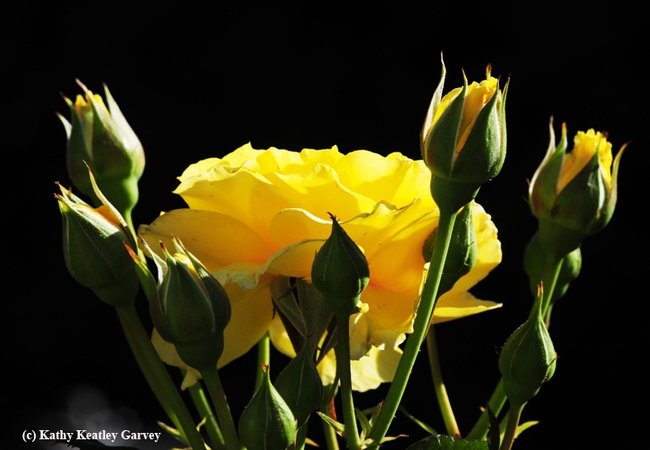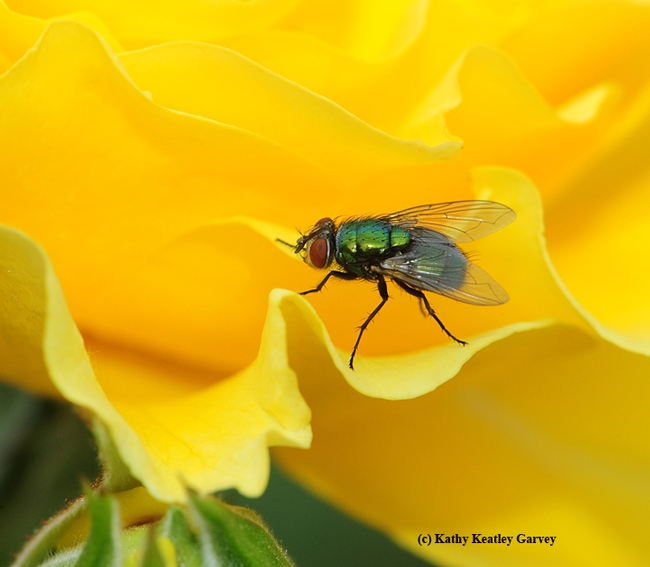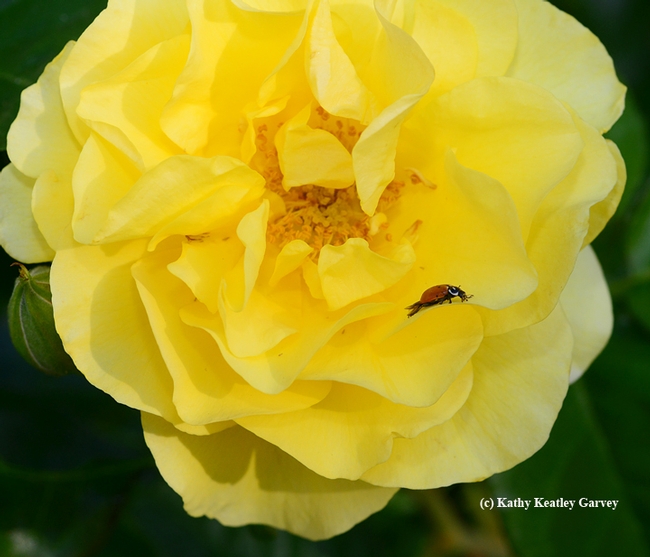
Posts Tagged: Foundation Plant Services
Stop and Smell the Roses at UC Davis Rose Weekend
Back in 2013 we purchased a stunning yellow rose, "Sparkle and Shine," at the UC Davis Rose Weekend. Well, it was a natural thing to do--a honey bee was on it! Honey bees aren't all that attracted to commercial roses, but this one was. Honey bees are still attracted to it. So are assorted lady...

A yellow rose, "Sparkle and Shine," does just that. (Photo by Kathy Keatley Garvey)

A green bottle fly cannot resist the scent of the yellow rose, "Sparkle and Shine." Flies are pollinators, too! (Photo by Kathy Keatley Garvey)
Everything's Coming Up Roses
UC Integrated Pest Management Program (UC IPM) staff distributed ladybugs (actually lady beetles, but when you say "lady beetles," someone is sure to ask "Aren't those LADYBUGS?") at Briggs Hall during the recent UC Davis Picnic Day. A welcome gift, indeed. We placed our two little...

A ladybug foraging on a yellow rose, Sparkle and Shine. (Photo by Kathy Keatley Garvey)
Sparkle and Shine!
It's not "Rise and Shine!" any more. It's "Sparkle and Shine." "Sparkle and Shine," a yellow rose related to the Julia Child Rose, drew quite a bit of attention at the UC Davis event, "Roses: the "Eyeconic Weekend," sponsored May 4-5 by the California Center for Urban...

Honey bee foraging on a yellow rose, "Sparkle and Shine!" (Photo by Kathy Keatley Garvey)

A sign tells it all. (Photo by Kathy Keatley Garvey)

Dave Fujino, executive director of the California Center for Urban Horticulture with Missy Gable, newly selected statewide director of the UC Master Gardener Program. (Photo by Kathy Keatley Garvey)
What's Not to Love About Roses?
I beg your pardonI never promised you a rose gardenAlong with the sunshineThere's gotta be a little rain sometime... So began Joe South in his hit song, "I Never Promised You a Rose Garden," popularized by country singer Lynn Anderson in 1970. That was Joe South's rose garden. What UC Davis has...

Yellow roses are popular at the rose sale. (Photo by Kathy Keatley Garvey)

This is what you don't want to see on your rose: rose curculio or rose weevil. You can ask questions about pests at the rose event. (Photo by Kathy Keatley Garvey)
New technology offers hope for solving grapevine red blotch disease

The virus is of particular concern to wine grape growers, whose grapes must reach a certain sugar content level before they are suitable for winemaking.
"The most urgent research need now is to determine how the virus spreads," said Deborah Golino, UC Cooperative Extension specialist in the Department of Plant Pathology at UC Davis and director of the UC Davis-based Foundation Plant Services.
"Due to the distribution of the virus in many parts of the United States and evidence that it can be transmitted by grafting, we suspect that red blotch disease is widespread wherever grapes are grown," Golino said.
Golino encouraged vineyard owners and managers to evaluate their vineyards for red blotch disease as they would for any other viruses.
Symptoms include blotches of pink or red veins on green leaves in the fall, when grape leaves would normally be turning a uniform gold color. Growers also might notice that their grapes are slow to develop sugar levels sufficient for winemaking, with some grapes never fully maturing.
"If there are visual signs of red blotch, as well as poor sugar development, growers should test their vines for both red blotch and leafroll virus because the symptoms of the two viruses are so similar," Golino said.
She reported that red blotch disease has been identified among both young and mature grape vineyards in California, New York, Virginia, Maryland, Pennsylvania, Texas and Washington. A virus almost genetically identical to red blotch also was found in Canada.
While the virus, also called grapevine red blotch-associated virus or GRBaV, likely can be found in all types of grapes, including rootstock, and table and raisin grapes, it was first detected in wine grapes because they are carefully monitored for sugar content to determine harvest date.
Presence of the virus in a vine can be confirmed using an extremely sensitive laboratory test known as polymerase chain reaction, or PCR, to detect small amounts of genetic material. This analytical process uses an amplification technique that multiplies the existing DNA and similar genetic material to identify the virus.
"If the vineyard tests positive for red blotch, the grower needs to decide, from an economic standpoint, when is the best time to remove the diseased vines and replant the vineyard," Golino said. "This is always a complex decision, and there is no one-case-fits-all answer."
Golino said that the Foundation Plant Services' Classic Foundation vineyard block, used for producing disease-free scion and rootstock vines, has been partially tested and appears to have a very low-level incidence of red blotch virus. Only three of the 1,600 vines tested to date were found to have the virus. Testing of all of the vines in the Classic Foundation vineyard, the source of the majority of grapevine nursery stock in California, is slated for completion in the months to come.
"The good news is that our new Russell Ranch Foundation Vineyard block has been tested, and there is no sign of red blotch virus in any of those vines," Golino said. This vineyard is propagated exclusively with vines that have been through tissue-culture therapy to exclude red blotch and other viruses. Test records from the Foundation Plant Services vineyards are available at http://fps.ucdavis.edu.
Golino cautioned that many more new viruses and other microbes are likely to be found in grapevines in the next few years, thanks to powerful new DNA sequencing technology.
"Some of those will be disease agents, some beneficial, and some neutral," she said. "We will have our work cut out for us in understanding the role of these microbes, but the ultimate result will be increased ability to create superior vineyards."
"The appearance of red blotch virus underscores the vital importance of the Foundation Plant Services and adequate funding for USDA's National Clean Plant Network," said John Aguirre, president of California Association of Winegrape Growers. "Growers need clean plant material to meet winery demands for increased winegrape production and improved quality."
Golino said that progress on identifying and characterizing red blotch has been a collaborative effort between many university-based researchers over the years.
Red blotch disease was first recognized in 2008 in a Napa Valley vineyard by Jim Wolpert, a UC Davis-based Cooperative Extension viticulturist, and Mike Anderson, a viticulture researcher and manager of UC Davis' Oakville Experiment Station.
Two UC Davis scientists - Mysore Sudarshana , a U.S. Department of Agriculture researcher in the plant pathology department, and Maher Al Rwahnih, a researcher at Foundation Plant Services - teamed up in an effort to identify the virus causing red blotch disease. Al Rwahnih was an early user of next-generation, or high-throughput DNA sequencing technology.
During today's meeting, Golino announced that California rootstock nurserymen acted last week to assist the California viticulture industry with research addressing GRBaV. The California Grape Rootstock Research Foundation, which funds research to enhance California viticulture and the grape nursery industry, has agreed to provide seed money to jumpstart research on the virus.
More information on red blotch disease is available on the University of California Integrated Viticulture website.
Foundation Plant Services is a self-supporting unit of the College of Agricultural and Environmental Sciences at UC Davis. The service, dedicated to the distribution of disease-tested, true-to-identity plant materials produced by UC researchers, plays a key national and international role in distributing new crop varieties and healthy planting stocks.
About UC Davis
For more than 100 years, UC Davis has engaged in teaching, research and public service that matter to California and transform the world.
Located close to the state capital, UC Davis has more than 33,000 students, more than 2,500 faculty and more than 21,000 staff, an annual research budget of nearly $750 million, a comprehensive health system and 13 specialized research centers. The university offers interdisciplinary graduate study and more than 100 undergraduate majors in four colleges -- Agricultural and Environmental Sciences, Biological Sciences, Engineering, and Letters and Science. It also houses six professional schools -- Education, Law, Management, Medicine, Veterinary Medicine and the Betty Irene Moore School of Nursing.
Media contacts:
- Deborah Golino, Foundation Plant Services, (530) 754-8102, dagolino@ucdavis.edu
- Pat Bailey, UC Davis News Service, (530) 752-9843, pjbailey@ucdavis.edu
